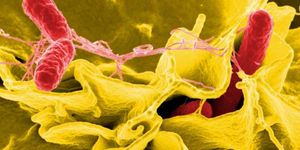Growing Microbes to Feed the World
With the ever-increasing population on earth, feeding the world is requiring more food production than ever before. The earth's population is expected to grow to nearly ten billion over the next thirty years, and agriculture production is not likely to keep up with current technologies. The challenges facing agriculture production include biotic stressors like disease and pests and abiotic stresses like high winds, drought, extreme temperatures, acid rain, changes in soil pH, soil salinity, and soil solidification. In the last century, these problems have been temporarily solved by adding fertilizers and pesticides to soils. Still, these solutions cannot keep up forever, and our soils are paying the price for such heavy production.
A resurgence of interest in soil sustainability and regenerative agriculture has also renewed interest in the development of soil microbes to assist with farming production. Many microorganisms are present in healthy soil, but years of preferring the quicker solution of instant fertilizers and pesticides have decreased their numbers and lessened the quality of many soils across the world.
Two of the broad categories of microbes with beneficial relationships to plant roots are mycorrhizal fungi and rhizobacteria. These microorganisms may grow inside the roots of plants (endophytes) or live on the outside of plant roots (epiphytes). These microbes have been shown to boost plant growth by protecting against diseases and stressors, improving plant nutrition, and promoting soil stability. Penicillium, Trichoderma, and Fusarium are the fungi families most commonly used by farmers in recent years.
These microbial relationships may be fundamental in reducing the number of chemical fertilizers farmers must use to achieve yields. Plants increase yields with healthy microbial communities, and harvests are of higher quality due to fewer stressors. In addition, fewer chemicals are required, which reduces the costs of inputs and makes farming less expensive.
Products to improve the health of these microbial communities are beginning to become commercially available in more significant numbers, and many more are in development. Both farmers and consumers are interested in long-term food security and sustainability. These microbes may be the key to the future of sustainable farming.
Sources: Physiological and Molecular Plant Pathology, Rhizosphere, The UN, Nature, Journal of Experimental Botany









